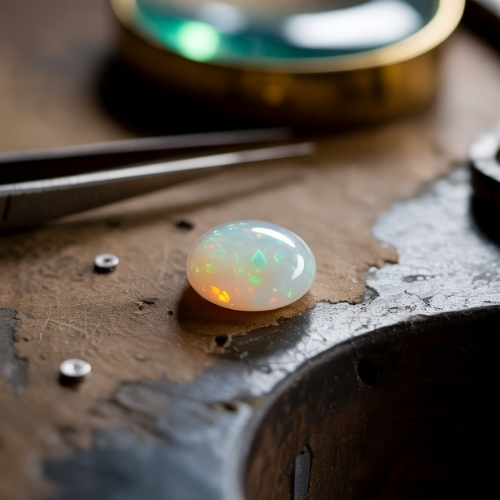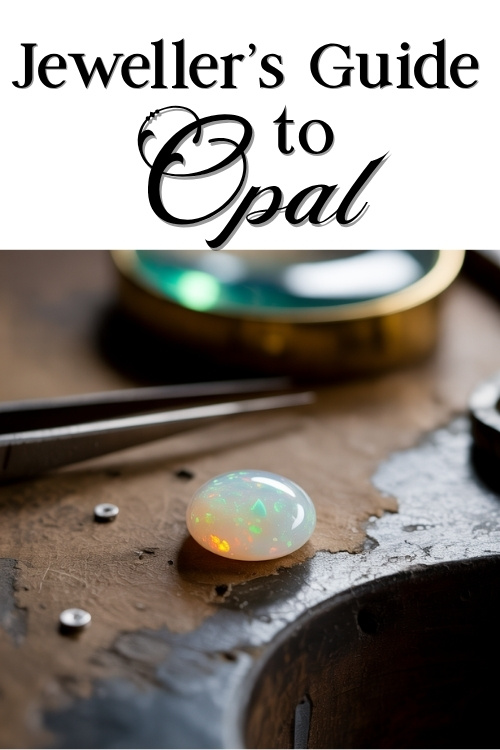There’s nothing quite like opal. With its ethereal play-of-colour, this gemstone captures light in a way that feels almost otherworldly. Whether it glows with pastel flashes or ignites in a dance of rainbow brilliance, each opal is entirely unique, making it a favourite among designers seeking personality and poetic beauty for their pieces.
Basic Identification Information
Name & Synonyms:
Opal.
See below for common trade names.
Species:
Opal
Colour Range:
White, black, grey, blue, green, orange, red, pink, brown, yellow, colourless.
Many opals display a striking play-of-colour with is an optical effect that causes rainbow-like flashes to appear and shift with movement.
Refractive Index:
1.370 – 1.470
Birefringence:
None as singly refractive
Optical Sign:
None as singly refractive
Pleochroism:
None
Specific Gravity:
1.25 – 2.23
Fluorescence:
From none to a strong response to UV light
When present these gems can fluoresce white, green, or yellow
Lustre:
Subvitreous (almost glass like) to waxy or resinous
Clarity (GIA clarity type):
Opal doesn’t have a clarity type as it’s very rarely transparent and even then it will usually be included, as it’s the inclusions that produce the classic play-of-colour.
Gems Often Mistaken For:
Opalite (glass)
Mohs Hardness:
5 to 6.5
Wearability:
Fair
Birthstone:
October (along with tourmaline)
Spotting Synthetic (Lab-Grown) Opal
Lab-created opals are widely available and can be visually stunning, but if you’re aiming for natural stones in your work, here are key features to help spot synthetic gems:
“Chicken Wire” or “Lizard Skin” Pattern
Many synthetic opals show a repeating, grid-like internal texture, sometimes called “snakeskin” or “chicken wire.” This uniform structure contrasts with the more organic, irregular play-of-colour seen in natural stones.
Even Colour in All Directions
Natural opals often reveal their colour best from specific angles. Synthetic stones tend to show consistent, bright play-of-colour across the entire surface and from all directions.
Columnar Structure in Side View
Especially in older types like Gilson opal, vertical growth lines may be visible when viewed from the side of a thicker cabochon, something you won’t find in natural specimens.
Too Perfect to Be Natural
Watch for uniformity. Natural opals typically have uneven distribution of colour and areas of potch (colourless opal), while synthetic varieties often appear flawless.
Common Treatments
Many opals on the market have been treated to enhance their beauty or improve durability. These enhancements are especially common in more fragile or porous material.
One common technique is sugar-acid or smoke treatment. This method darkens the body tone of the opal, which can intensify its play-of-colour. The result is often a more dramatic, vibrant appearance.
Some porous opals are dyed or impregnated with plastic or resin. This strengthens the stone and helps prevent cracking, but it also alters the gem’s natural feel.
Doublets and triplets are another way to make use of thinner or lower-quality opal. In a doublet, a slice of opal is backed with a darker material to enhance contrast. A triplet goes a step further, adding a clear quartz or glass cap to protect the stone and enhance brilliance.
Each of these treatments changes how the opal should be handled and worn. For jewellers, confirming whether a stone is solid, treated, or composite is essential before setting.
Durability & Setting Considerations
Opal is a soft and brittle gem. With a Mohs rating between 5 and 6.5, it’s softer than household dust making it vulnerable to scratches. While it’s brittleness means it chips quiet easily and needs protecting.
Because opal is delicate, it’s best reserved for jewellery that won’t face frequent bumps or abrasion. Think earrings, pendants, and brooches. When used in rings, opal is better suited to occasional wear rather than everyday use. And a protective setting, such as a bezel, is essential to help shield the stone from damage.
Hydrophane opals, commonly found in Ethiopian material, present a unique challenge. These stones can absorb water and temporarily change in appearance, often becoming more transparent or losing their fire until they dry out. There is also the risk of them cracking as they dry. They should be kept away from moisture whenever possible, and clients should be informed of this behaviour when choosing a design.
Care Instructions
Cleaning
Don’t submerge them in water. Instead use a soft cloth dampened with warm, soapy water and be gentle. Ultrasonic or steam cleaners can cause damage and should never be used.
Storage
To prevent scratching, store opals separately from harder gems in a padded box or soft pouch.
In very dry environments, it’s helpful to store them in a sealed container with a small, slightly damp cloth nearby. This can help prevent dehydration, especially in hydrophane varieties.
Daily Wear
Opals are more suited to occasional wear. They perform well in earrings, pendants, and brooches where contact is limited. If the gem is set into a ring, advise clients to remove it during strenuous tasks or when working with water or chemicals.
Market & Ethical Notes
Opals are mined in several regions across the world, each producing distinctive material.
Australia remains the most famous source, particularly for black, white, and boulder opals. These stones are often considered the most stable and least likely to be treated, making them highly valued in the trade.
Ethiopia has become a major supplier in recent years. Its crystal opals can be vivid and striking, but many are hydrophane and require extra care. Treatments to stabilise colour or improve durability are more common with Ethiopian material.
Mexico is known for its fire opals. a transparent stones that range from yellow to deep orange-red.
As always, ethical sourcing is essential. Work with trusted suppliers who are transparent about origin and treatment. This not only protects your reputation but ensures your clients understand the true nature of the gems in their jewellery.
Symbolic & Spiritual Meanings
Opal is often associated with intuition, inspiration, and creative expression. Its shifting colours are said to symbolise transformation and emotional depth, making it a stone linked to the inner self.
Opal is also believed to awaken imagination, and some view it as a reflective gem that mirrors one’s mood or energy.
🔗 Dive deeper into Opal’s Symbolic & Spiritual Meanings
Etymology
The word “opal” comes from the Latin opalus, which likely stems from the ancient Sanskrit upala, meaning “precious stone.”
🔗Curious about how opal was viewed in ancient cultures? Explore its fascinating myths and legends (coming soon)
Varieties and Trade Names
I’ve chosen to focus on precious opal (opal that can show play-of-colour) for this list, rather than covering the full range, including common opals, just to prevent it from being too long.
- White Opal – Light body tone with play-of-colour
- Black Opal – Dark body tone; prized for vibrant colour flashes
- Boulder Opal – Opal formed within ironstone matrix, usually from Queensland
- Yowah Nuts – Ironstone nodules from Yowah, Queensland that may contain pockets or veins of opal. Often cut open to reveal vibrant colour play inside. These are a type of bolder opal.
- Crystal Opal – Transparent to translucent with strong play-of-colour
- Fire Opal – Orange, red or yellow; may or may not show play-of-colour
- Honey Opal – A transparent to translucent opal with a warm golden-yellow or amber tone. May or may not show play of colour.
- Jelly Opal – A translucent to semi-transparent opal with a gelatinous, glowing appearance. Often has a soft play of colour and a smooth, watery look.
- Matrix Opal – A type of opal where the play-of-colour is naturally distributed within the host rock, often creating a speckled or web-like effect.
- Andamooka Matrix Opal – A specific type of porous matrix opal (typically from Andamooka) treated with sugar and acid to darken the body tone and highlight colour play.
- Painted Lady – A type of matrix opal from Andamooka, South Australia, named for its vivid, painterly patches of colour spread across a tan matrix.
- Opalized Fossils – Fossilised bones, shells, or wood that have been replaced or filled with opal. These can include dinosaur bones and ancient sea life, often with striking colour flashes.
- Potch – Opal with no play-of-colour, can be lovely in pastel shades, sometimes called common opal.
📌 Save this jeweller’s guide to opal for quick reference next time you’re working with this mesmerising gem.


